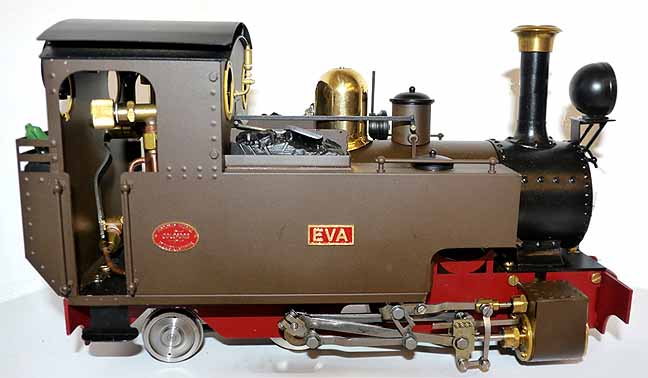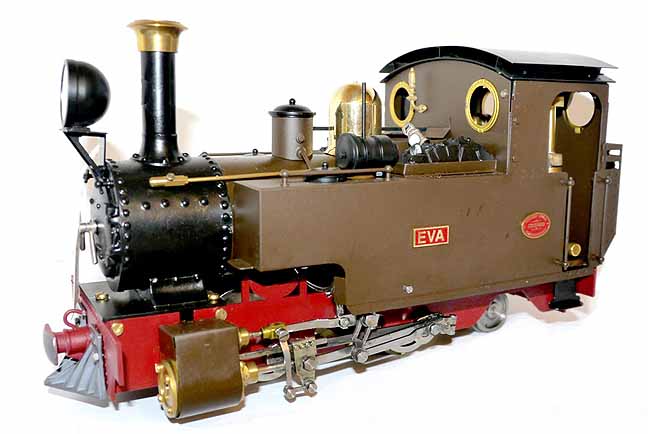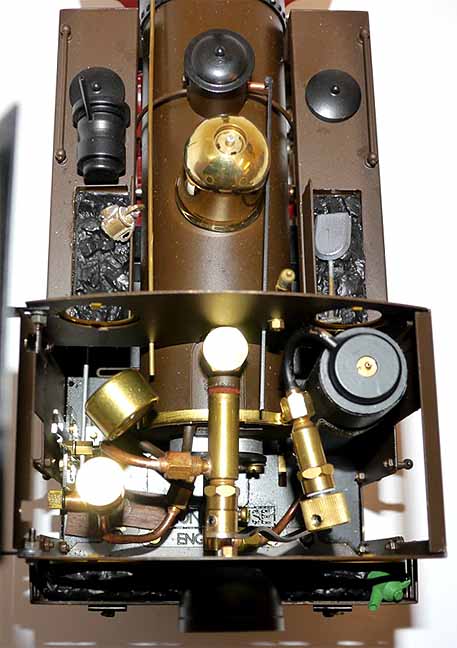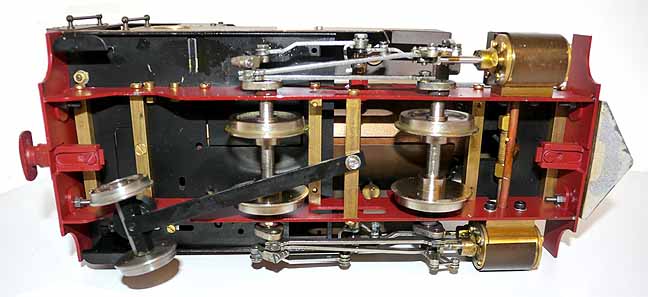Back to Sidestreet Bannerworks
Click here to find out how your engine can be featured!
.


Harvey Watkins' 0-4-2T
by Bert Horner
Zwischenwasser, Austria
Photos by the author
November, 2012
Some time ago I was talking via video with Simon Whenmouth of Anything Narrow Gauge in the UK, and saw what looked like a Roundhouse "Lady Anne" sitting on a shelf in the background. During our conversation I asked him why a common Lady Anne should be on display in his office. Perhaps I should mention that Simon collects, buys, and sells, used live-steam engines and supplies new ones. I live in Austria, in the heart of Europe, and my link to the English model market is to 85% via Simon. His description of his goods is perfect and he is a gentleman of honor. Sorry -- back to the “Lady Anne.”
He brought the engine closer to the camera and -- surprise, surprise -- the body was "Lady Anne" but the chassis and boiler seemed to be from her sister "Katie." The engine was fitted with typically large colonial-style headlights, a cowcatcher, a boiler-top sand pot, and a safety-valve cover from perhaps a "Lady Anne" or an Argyle engine. Unusually, a steam dynamo sat on the left water tank and the cab had been fitted with a tropical double roof.
For those of you who know the Roundhouse "Billy" and "Katie" chassis, the slot under the cab had been opened towards the bottom to allow the addition of a trailing truck, which had been fitted to swing out in curves without fouling the frames. This is attached radially to the center bottom chassis cross member.
All of the cab fittings are standard Roundhouse, as one would expect, and I think most of us know this layout.
Background
Now what made Harvey Watkins build this engine? It is not known for sure. However, I am told that he had been doing some research on an Indian engine (Indian and 7/8"-scale engines were his special area) and he had seen, in passing, a little brown 0-4-2 tank engine. This little engine reminded him of a "Lady Anne."
Later, he came across some parts he had stored away in his workshop. These included a chassis and boiler and a "Lady Anne" body, and so, I am told, it came that this little one-off engine rolled out of his workshop, painted like the photo from which it was built, with a red chassis, brown cab, tanks, and boiler, and black smokebox, cowcatcher, and cab roof. I have also been informed it is a good representation of the prototype he had seen. It then found its way into the hands of a collector who, I am sure, judging from the condition of the engine, did not run it. It then came into the hands of the above mentioned dealer.
Needless to say the little engine was soon on its way to Austria, where it now lives. It is a typical Roundhouse engine, it runs very well and is very controllable. I have a pet dislike for Roundhouse valve gear, which looks, to my eye, primitive -- looking somehow like wrought ironwork -- and looks very much out of scale. As I said, though, it runs typically very well and probably will do so for years to come.
I do not know the age of the engine. I do know it has seen very little running, if any, other than testing, because there is hardly a mark on the wheel treads and no sign of oil under the smoke-box and cylinders. That is about all I can say about the model so now out onto the track and boil some water.
A test run
The test day was a gray day in early September. The temperature was about 23°C (74°F). After moving down into the valley from my larger home in the mountains (a smaller accommodation), my railway space is cramped but allows continuous running in a space only 8 x 6 meters.
I set a short train of four 2’-gauge War Department open bogie wagons (gondolas) and a brake van onto the track and filled the first gondola with solid wood packing cases to give the train a little weight. The engine was brought out of its case, onto my service table, and given a quick check that all valve-gear screws etc. were up tight. Having satisfied myself all was okay, I then oiled all moving parts sparingly with lathe-bed oil. I use this oil because it does not get thrown out of bearings when the valve gear is moving fast. The next step was to fill the gas tank, followed by the steam oiler, and finally, the boiler.
I set the engine on my rolling-road test bed, made sure it was sitting good, cracked the gas valve, and offered my lighter to the top of the chimney. The fire caught at once but burned intermittently for a while until the gas had stabilised. I adjusted the flame to burn as I wanted it to -- that is, with the flame audible but not loud.
After between four and five minutes, the gauge was showing around 40 psi, so the reversing lever was eased forward and the regulator opened. Hot water and oil shot out of the chimney and from under the smokebox into the catch tray I had under the rolling road. I allowed the to run a minute or so until it was running smoothly with the regulator just cracked.
I then placed the reverser in the middle, lifted the engine down onto the track, and coupled it to the waiting train. By now the safety was lifting, so I cut the flame back a little eased the reverser forward and readjusted the regulator. It was stop-and-go for the next three or four meters, then it took off at quite a high speed. However, after a couple of runs around my short line and another slight adjustment, it settled down to some nice, slow scale-speed running. It kept up this pace for 17 minutes, then started to slow a little, and the fire was somewhat quieter due to falling pressure. I opened the gas valve a little more and off it went again, at first a little faster, as before, but soon settled down again.
It ran another five laps of my line, then the fire went out with a light "plop." Steam in the boiler kept it running for another 15 meters or so, then it was the end of an enjoyable run from an almost-new engine.
I blew the water out of the in-line oiler, opened the boiler-water filler screw a couple of turns to break the vacuum, then wiped off the little oil that was under the smokebox. I then allowed the engine to cool off before cleaning it up and putting it back into its case.
The engine looks so nice I have decided it will get a set of three Darjeeling coaches to give a full colonial train. They may even get populated with a couple of Mr Bennet's fitting figures.
|
|
|
| Builder | Harvey Watkins (UK) |
| Date completed | Unknown |
| Gauge | 1 (45mm) |
| Scale | 16mm = 1'0" |
| Boiler type | Center flue |
| Fittings | Steam Regulator, Safety Valve, water gauge, top up valve |
| Fuel | Butane |
| Cylinders | Two, double-acting D-valve |
| Reversing gear | Simplified Walschaerts |
| Lubricator | Displacement |
| Blowoff pressure | 40 psi |





Back to Sidestreet Bannerworks
Click here to find out how your engine can be featured!
This page and its contents
Copyright Sidestreet Bannerworks, 2012